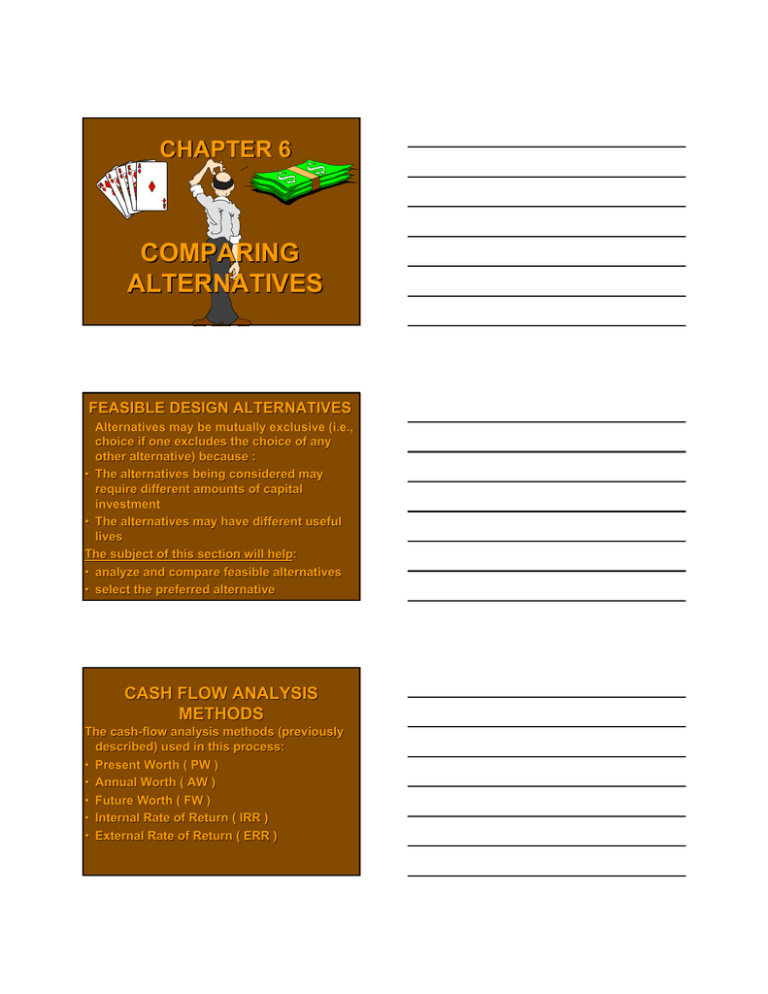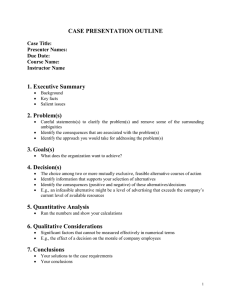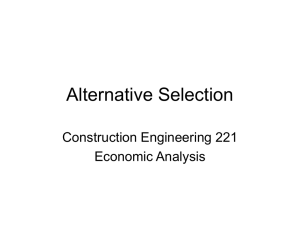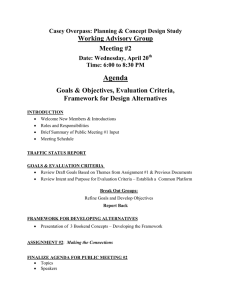COMPARING ALTERNATIVES
advertisement

CHAPTER 6 COMPARING ALTERNATIVES FEASIBLE DESIGN ALTERNATIVES Alternatives may be mutually exclusive (i.e., choice if one excludes the choice of any other alternative) because : • The alternatives being considered may require different amounts of capital investment • The alternatives may have different useful lives The subject of this section will help: help: • analyze and compare feasible alternatives • select the preferred alternative CASH FLOW ANALYSIS METHODS The cashcash-flow analysis methods (previously described) used in this process: • Present Worth ( PW ) • Annual Worth ( AW ) • Future Worth ( FW ) • Internal Rate of Return ( IRR ) • External Rate of Return ( ERR ) RULE FOR CHOOSING AMONG ALTERNATIVES • The alternative that requires the minimum investment and produces satisfactory functional results will be chosen unless the incremental capital associated with an alternative having a larger investment can be justified with respect to its incremental savings (or benefits ). • The alternative requiring the least investment is the base alternative. alternative. • Rule ensures that as much capital as possible is invested at a rate of return equal to or greater than the MARR. ENSURING COMPARABLE BASIS FOR SELECTING MUTUALLYMUTUALLY-EXCLUSIVE ALTERNATIVES Include any economic impacts of alternative differences in estimated cash flows – Two Rules: Rules: Rule 1. 1. When revenues and other economic benefits are present, present, select alternative that has greatest positive equivalent worth at ι = MARR and satisfies project requirements. Rule 2. 2. When revenues and economic benefits are not present, present, select alternative that minimizes cost. INVESTMENT ALTERNATIVES Those alternatives with initial (i.e., frontfront-end) capital investments(s) that produce positive cash flows from increased revenue, savings through reduced costs, or both. COST ALTERNATIVES Those alternatives with negative cash flows except for a possible positive cash flow element from disposal of assets at the end of the project’s useful life. PLANNING HORIZON • The selected time period over which mutually exclusive alternatives are compared -- study period • May be influenced by factors including: – – – – service period required useful life of the shortershorter-lived alternative useful life of the longerlonger-lived alternative company policy • It is key that the study period be appropriate for the decision situation under investigation USEFUL LIFE • Useful life of an asset is the time period during which it is kept in productive use in a trade or business. REPEATABILITY ASSUMPTION • The study period over which the alternatives are being considered is either indefinitely long or equal to a common multiple of the lives of the alternatives. • The economic consequences that are estimated to happen in an alternative’s initial useful life span will also happen in all succeeding life spans (replacements) Actual situations in engineering practice seldom meet both conditions COTERMINATED ASSUMPTION • A finite and identical study period is used for all alternatives • This planning horizon, combined with appropriate adjustments to the estimated cash flows, puts the alternatives on a common and comparable basis • Used when repeatability assumption is not applicable • Approach most frequently used in engineering practice COTERMINATED ASSUMPTION Guidelines when useful life(s) different in length than study period • Useful life < study period a. Cost alternatives -- each cost alternative must provide same level of service as study period : 1) contract for service or lease equipment for remaining time; 2) repeat part of useful life of original alternative until study period ends b. investment alternatives -- assume all cash flows reinvested in other opportunities at MARR to end of study period COTERMINATED ASSUMPTION Guidelines when useful life(s) different in length than study period • Useful life > study period Truncate the alternative at the end of the study period using an estimated market value. This method assumes disposable assets will be sold at the end of the study period at that value SELECT THE EQUIVALENT WORTH ALTERNATIVE WITH THE GREATER WORTH • If : PWA (i) < PWB (i) • • • • then PWA (i) ( A / P,i P,i,N ) < PWB (i) ( A / P,i P,i,N ) and AWA (i) < AWB (i) similarly PWA (i) ( F / P, i, N ) < PWB (i) ( F / P, i, N ) and FWA (i) < FWB (i) Select alternative B COMPARING COST ALTERNATIVES • For cost alternatives that are compared using the PW method, the alternative that has the least negative PW is most economically desirable. • For cost alternatives that are compared using the AW method, the alternative that has the least negative AW is most economically desirable. • For cost alternatives that are compared using the FW method, the alternative that has the least negative FW is most economically desirable. USING RATE OF RETURN METHODS TO EVALUATE MUTUALLY EXCLUSIVE ALTERNATIVES The best alternative produces satisfactory functional results and requires the minimum investment of capital, unless a larger investment can be justified with respect to the incremental costs and benefits it produces RATE OF RETURN METHOD RULES 1. Each increment of capital must justify itself by producing a sufficient rate of return on that increment. 2. Compare a higher investment alternative against a lower investment alternative only when the latter is acceptable. 3. Select the alternative that requires the largest investment of capital as long as the incremental investment is justified by benefits that earn at least the MARR. This maximizes equivalent worth on total investment at i = MARR. INCONSISTENT RANKING PROBLEM • Ranking errors can occur when a selection among mutually exclusive alternatives is based wrongly on maximization of IRR on the total cash flow, as opposed to the PW of the total cash flow • When the MARR is less than the IRR of the difference between alternative cash flows, an incorrect choice will be made by selecting an alternative that maximizes the IRR of its total cash flow, because -- the IRR method assumes reinvestment of cash flows at the calculated rate(s) of return -- the PW method assumes reinvestment at the MARR INCREMENTAL INVESTMENT ANALYSIS PROCEDURE ( Helps avoid incorrect ranking problem ) 1. Order the feasible alternatives. 2. Establish a base alternative a. Cost alternatives -- The first alternative is the base b. Investment alternatives - If the first alternative is acceptable, select as base. If the first alternative is not acceptable, choose the next alternative 3. Use iteration to evaluate differences (incremental cash flows) between alternatives until no more alternatives exist a. If incremental cash flow between next alternative and current alternative is acceptable, choose the next b. Repeat, and select as the preferred alternative the last one for which the incremental cash flow was acceptable THREE ERRORS COMMON TO INCREMENTAL INVESTMENT ANALYSIS PROCEDURE APPLIED TO IRR Choosing the feasible Alternative with: 1. the highest overall IRR on total cash flow 2. the highest IRR on an incremental capital investment 3. the largest capital investment that has an IRR greater than or equal to the MARR Incremental analysis must be used with rate of return methods to ensure the best alternative is selected INCREMENTAL ANALYSIS PROCEDURE USED WITH EQUIVALENT WORTH METHODS • Equivalent worth methods may also be applied using the incremental analysis procedure to compare mutually exclusive alternatives • Alternative ranking will be consistent with equivalent worth values based on total investment of each alternative • Ranking will be consistent with ROR methods when using incremental analysis • When equivalent worth of investment cash flow > 0 at i = MARR, its IRR > MARR • Equivalent worth methods using incremental investment analysis can be used as a screening method for the IRR method IMPUTED MARKET VALUE TECHNIQUE • When current marketplace data is unavailable for an asset, it is sometimes necessary to estimate the market value of an asset • Referred to as an imputed or implied market value • Estimating is based on logical assumptions about the remaining life for the asset MVT = [ EW at the end of year T of remaining capital recovery amounts ] + [ EW at the end of year T of original market value at the end of useful life ] T < useful life EW is equivalent worth at i = MARR COMPARING ALTERNATIVES USING THE CAPITALIZED WORTH METHOD • Capitalized Worth (CW) method -- Determining the present worth of all revenues and / or expenses over an infinite length of time • Capitalized cost -- Determining the present worth of expenses only over an infinite length of time • Capitalized worth or capitalized cost is a convenient basis for comparing mutually exclusive alternatives when a period of needed services is indefinitely long and the repeatability assumption is applicable CAPITALIZED WORTH METHOD 8 8 8 8 • Capitalized worth of a perpetual series of endend-ofof-period uniform payments, A, with interest i% per period: A ( P /A, i%, ) CW = PWN --> = A ( P / A, i%, ) --> N ( 1+i 1+i ) - 1 = A lim ------------= A(1/i) N --> --> i ( 1 + i )N THREE GROUPS OF MAJOR INVESTMENT ALTERNATIVES 1. Mutually exclusive : At most one project out of the group can be chosen 2. Independent : The choice of a project is independent of the choice of any other project in the group, so that all or none of the projects may be selected or some number in between 3. Contingent : The choice of the project is conditional on the choice of one or more other projects


